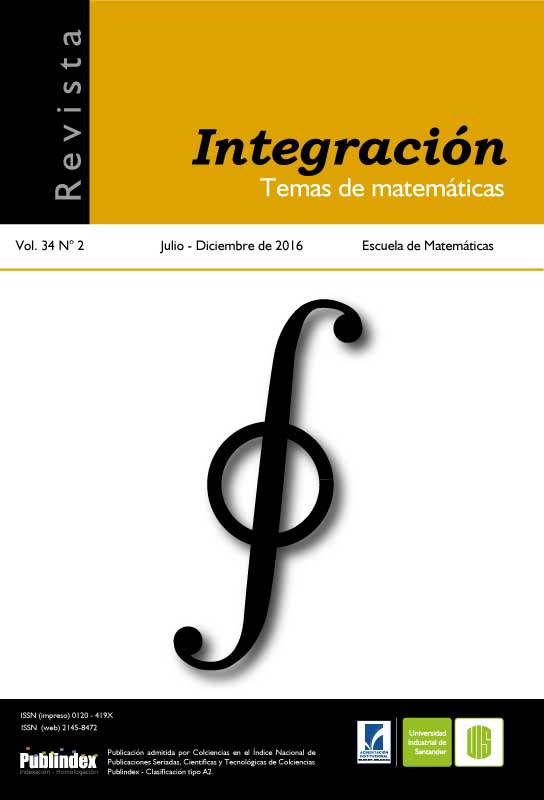Publicado 2016-12-12
Palabras clave
- Red neuronal,
- problema de complementariedad no lineal,
- estabilidad,
- reformulación
Cómo citar
Resumen
En este artículo presentamos un modelo de red neuronal para resolver el problema de complementariedad no lineal. Para ello, reformulamos este problema como uno de minimización sin restricciones usando una familia uniparamétrica de funciones de complementariedad. Demostramos resultados de existencia y convergencia de la trayectoria de la red neuronal, así como resultados de estabilidad en el sentido de Lyapunov, estabilidad asintótica y exponencial. Además, presentamos resultados numéricos preliminares que ilustran un buen desempeño práctico del modelo.
Para citar este artículo: F. Arenas, R. Pérez, H. Vivas, Un modelo de redes neuronales para complementariedad no lineal, Rev. Integr. Temas Mat. 34 (2016), No. 2, 169-185
Descargas
Referencias
- Arenas F., Martínez H.J. and Pérez R., "Least change secant update methods for nonlinear complementarity problem", Ingeniería y Ciencia 11 (2015), 11-36.
- Arenas F., Martínez H.J. & Pérez R., "Redefinición de la función de complementariedad de Kanzow", Revista de Ciencias 18 (2014), No. 2, 111-122.
- Arias C.A., Un algoritmo cuasi Newton global para problemas de complementariedad no lineal, Tesis de Maestría, Universidad del Cauca, 2014, 44 p.
- Billups S. C., Algorithms for complementarity problems and generalized equations, Thesis (Ph.D.), University of Wisconsin, 1995.
- Burden R.L. & Douglas Faires J., Análisis Numérico, 7ma ed., Thomson Learning, 2002.
- Chen J-S., Ko C-H. and Pan S., "A Neural network based on the generalized Fisher-Burmeister function for nonlinear complementarity problems", Information Sciences 180 (2010), No. 5, 697-711.
- Chen J-S. and Pan S., "A family of NCP functions and a descent method for the nonlinear complementarity problem", Comput. Optimi. Appl. 40 (2008), No. 3, 389-404.
- Clarke F.H., Optimization and nonsmooth analysis, John Wiley & Sons, Inc., New York, 1983.
- De Luca T., Facchinei F. and Kanzow C., "A semismooth equation approach to the solution of nonlinear complementarity problems", Math. Programming 75 (1996), No. 3, Ser. A, 407-439.
- Dennis J.E., Jr. and Schnabel R.B., Numerical methods for unconstrained optimization and nonlinear equations, Prentice Hall, Inc., Englewood Cliffs, NJ, 1983.
- Ding J. and Yin H., "A new homotopy method for solving non-linear complementarity problems", Numer. Math. J. Chi. Univ. (Engl. Ser.) 16 (2007), No. 2, 155-163.
- Ferris M.C. and Pang J.S., "Engineering and economic applications of complementarity problems", SIAM Rev. 39 (1997), No. 4, 669-713.
- Fischer A., "A special Newton-type optimization method", Optimization 24 (1992), No. 3-4, 269-284.
- Hopfield J. and Tank D.W., "Neural computation of decisions in optimization problems", Biol. Cybernet. 52 (1985), No. 3, 141-152.
- Kanzow C.J. and Kleinmichel H., "A new class of semismooth Newton-type methods for nonlinear complementarity problems", Computat. Optimi. Appl. 11 (1998), No. 3, 227-251.
- Kostreva M., "Elasto-hdrodynamic lubrication: An non-linear complementarity problem", Internat. J. Numer. Methods Fluids 4 (1984), No. 4, 377-397.
- Liao L-Z, Qi H. and Qi L., "Solving nonlinear complementarity problems with neural networks: a reformulation method approach", J. Comput. Appl. Math. 131 (2001), No. 1-2, 343-359.
- Lillo W.E., Loh M.H., Hui S. and Zak S.H., "On solving constrained optimization problems with neural networks: apenalty method approach", IEEE Trans.Neural Networks 4 (1993), No. 6, 931-940.
- Nocedal J. and Wright S.J., Numerical optimization, Second ed., Springer, New York, 2006.
- Pang J-S. and Qi L.Q., "Nonsmooth equations: motivation and algorithms", SIAM J. Optim. 3 (1993), No. 3, 443-465.
- Pérez R., Lopes V.L.R. and Martínez J.M., "On the local convergence of quasi-Newton methods for solving non linear complementarity problems", Appl. Numer. Math. 30 (1999), No. 1, 3-22.
- Qi L.Q., "Convergence analysis of some algorithms for solving nonsmooth equations", Math. Oper. Research 18 (1993), No. 1, 227-244.
- Qi L.Q. and Sun J., "A nonsmooth version of Newton method", Math. Programming, 58 (1993), No. 3, Ser. A, 353-368.
- Wardrop J.G., "Some theorical aspects of road traffic research", Proceedings of the ICE 1 (1952), No. 3, 325-362.
- Watkins D.S., Fundamentals of matrix computations, Second ed., Wiley-Interscience, New York, 2002.
- Xu Q. and Dang C., "A new homotopy method for solving non-linear complementarity problems", Optimization 57 (2008), No. 5, 681-689.
- Zabczyk J., Mathematical control theory: an introduction, Birkhäuser, Boston Inc., Boston, MA, 1992.
